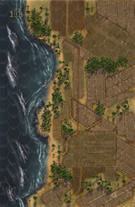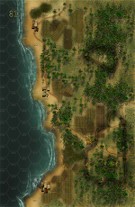|
Orote: Round Two Marianas 1944 #20 |
||
|---|---|---|
| (Defender) Japan | vs | United States (Attacker) |
| Formations Involved | ||
|---|---|---|
| Japan |  |
38th Infantry Regiment |
| Japan |  |
54th Naval Guard Force |
| Japan |  |
60th Anti-aircraft Defense Unit |
| United States |  |
22nd Marine Regiment |

|
| Overall Rating, 2 votes |
|---|
|
4.5
|
| Scenario Rank: --- of 940 |
| Parent Game | Marianas 1944 |
|---|---|
| Historicity | Historical |
| Date | 1944-07-28 |
| Start Time | 15:30 |
| Turn Count | 20 |
| Visibility | Day |
| Counters | 71 |
| Net Morale | 0 |
| Net Initiative | 2 |
| Maps | 2: 101, 81 |
| Layout Dimensions | 56 x 43 cm 22 x 17 in |
| Play Bounty | 157 |
| AAR Bounty | 165 |
| Total Plays | 2 |
| Total AARs | 2 |
| Battle Types |
|---|
| Exit the Battle Area |
| Inflict Enemy Casualties |
| Cave Control |
| Entrenchment Control |
| Conditions |
|---|
| Caves |
| Entrenchments |
| Minefields |
| Off-board Artillery |
| Randomly-drawn Aircraft |
| Scenario Requirements & Playability | |
|---|---|
| Marianas 1944 | Base Game |
| Saipan 1944 | Maps + Counters |
| Introduction |
|---|
|
The battle for the Orote Peninsula had been raging since July 24th. On the 28th of July Brigadier General Shepherd went forward on a reconnaissance of his front lines and quickly sized up the gravity of the situation holding up his 1st Provisional Brigade. His Marines' morning attack ran into trouble, resulting in a request to General Bruce, the 77th Division’s commander, to send tank destroyers and tanks to complement the Marine armor for a second attack. Shepherd then ordered Lt. Colonel Shapley to organize a tank-infantry attack with all available units to finally crack the Japanese fortified line of casemates and emplacements. |
| Conclusion |
|---|
|
Between July 27th and July 28th the massive armor and Infantry attack cracked the Rifle Range defensive line. The Marines found the rubble of their former Barracks as well. Tired Marines counted approximately 250 enemy casemates and emplacements destroyed in the Orote Peninsula. On July 29th the assault continued against limited resistance, and that afternoon the Marines captured the Orote Airfield. Later that day the Marines held a flag raising ceremony to formally reclaim the peninsula. Some minor mopping up continued on July 30th. The Orote Peninsula cost Japanese another 2,500 troops against U.S. losses of 115 killed, 721 wounded, and 38 missing. On a side note, Japanese Lieutenant General Takeshi Takashima died this day from machinegun fire, and General Obata assumed command of the island defense. |
| Additional Notes |
|---|
|
American morale and initiative are transposed. |
| AFV Rules Pertaining to this Scenario's Order of Battle |
|---|
|
| 1 Errata Item | |
|---|---|

|
The 8-3 Marine Infantry counter appears in most of the Saipan 1944 and Marianas 1944 scenarios, replacing the 10-3 DF valued Marine counters for those scenarios and is currently published in the most recent Saipan printing. (JayTownsend
on 2015 Dec 26)
|
| In Trying to Hold Everything, They Ended Holding Nothing | ||||||||||||
|---|---|---|---|---|---|---|---|---|---|---|---|---|
This is a great scenario, Japanese with a cave, an entrenchment and 4 casemates and 3 mines, with both regular army and SNLF trying to stop the Marines, with Army armor support and air cover, from taking 5 of those 6 items and exit the board with 25 steps. I strung the Japanese out across the peninsula so that all objectives had at least one stack of Japanese troops adjacent and a small force holding it. Casemates and mines were strung out and the AA guns placed overlooking roads that I hoped would be the focal point for the US armor having to find a way around the jungle hexes. The Marines and Army armor enter from the east edge, and I made up stacks of infantry and HMGs, with a stack of Engineers and infantry, and another with the Flame and an infantry, and moved them along the edges of the road on the northern board but with no road exiting the east on the southern board they had to walk slowly through what open ground there was while watching for possible attacks. Even with the lack of roads on the south-eastern board, both forces moved roughly parallel to each other, the Major, a stack of infantry and HMG with him, an M-4 and the M-10 adjacent, and an LT with the engineer and another infantry bringing up the rear of the northern attack force, while the LTC lead the southern force, with the halftrack and 2 more Sherman platoons supporting him and his men. The Flame unit went to a captain with another infantry, while the LTs lead combination Infantry and HMG stacks, the Sergeant with the Major just in case a second leader became needed, an LT with the LTC for the same reason. Never know when even the best leaders find themselves demoralized for a turn or two and it's safe to keep an extra leader in there with them when you have them available, and this scenario has plenty for the US. As the line moved west, the first Japanese elements were spotted and brought under the devastating OBA, eliminating all but one step of Infantry and leaving them primed for a followup assault by the Marine LT and his men while the armor and the rest of the northern force walked on around it. Assaults in the middle of the southern board picked up as the Japanese holding the cave came into view. Ironically, it was a long range AT shot from the Japanese 47mm guns hold up in the southwestern town hex that did the only damage for the game, in taking one step of the Marine M3/75 and demoralizing the other step. With that shot, the OBA shifted and after the smoke cleared, the only thing left in the town was the intact but demoralized AT guns. The halftracks stayed back to regroup while the infantry moved forward, and one by one, the casemates came into play, being eliminated in a few instances by concentrated OBA and in a few others, in assaults, but none caused much more than a short delay as the Marines first spotted for OBA and air support and then poured the direct fire in with one stack and assaulted with another. The game was winding down, the southern board clear, with only the entrenchment and one more casemate on the northern half, and the 30-factor OBA had dried up, so Marines in the southern board started heading for the west edge of the board while the LTC moved north with the Shermans to increase the pressure. At the end of 14 turns, the Northern force had eliminated the SNLF troops holding the entrenchment while the LTC and his troops destroyed the last casemate, leaving only a slightly damaged stack of Japanese infantry in a heavy jungle hex with fire coming from all sides but targets too far away to engage with any success, while the last of the artillery found them. The 25 steps made it off the table, and all 6 of the objectives were in US hands, so I saw no point in playing it out to the end to see if that last holdout could inflict any casualties. Leave them for mopping up later. Great game. |
||||||||||||
| 0 Comments |
| Marianas 1944, scenario #20: Orote: Round Two | ||||||||||||
|---|---|---|---|---|---|---|---|---|---|---|---|---|
Marianas 1944, scenario #20: Orote: Round Two This had the classic Pacific Battle feel and hit the spot but it is better played as the American player or solitary as the Japanese pretty much defend in fixed positions but can shift some forces in the early stages of the battle. The Marines and some added Army armor assault from the east in two groups and it became almost two parallel battles but you could shift units from the north map to the south map and vice versa but it would take a long time due to the difficult terrain. Armor led the charge followed closely behind by Infantry units in both attacks. The Marines had to overcome minefields, casemates, caves & entrenchment and still exit 25 or more units off the west edge of the map but had very good support in off-board artillery and air-support. Keeping the POI/ENG handy for mines and the FLM Engineers handy for assaults, to cancel out the enemies fire-first in many fixed positions was key. The Marines were able to take all the casemates, caves and entrenchments and exited 27 steps, keeping some behind to guard the entrenchment and cave hexes, so the enemy didn’t reoccupy them as there were still enough Japanese steps running around in the jungles, even after eliminating 19 steps and 4 leaders. The Marines had one of their best performances, losing only one Infantry step and one Army M10 tank destroy step to an enemy 47mm AT gun. Kind of cool, the first time I got the use an M10 in a Pacific Battle. Yes, the Americans easily won this scenario but it was a very enjoyable scenario to play! |
||||||||||||
| 0 Comments |

 MARI019
MARI019 

































